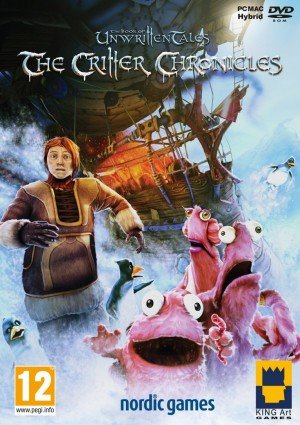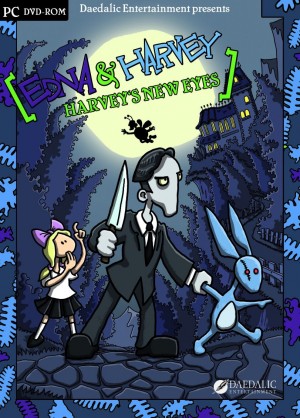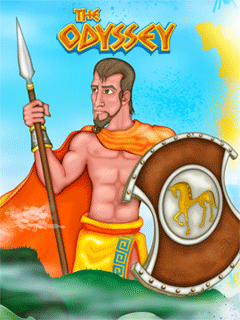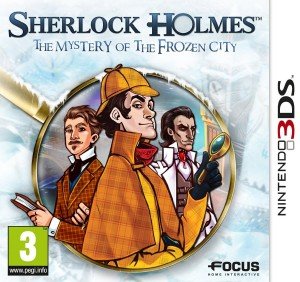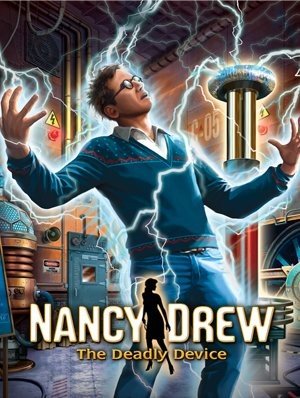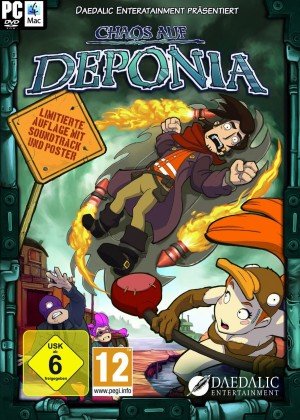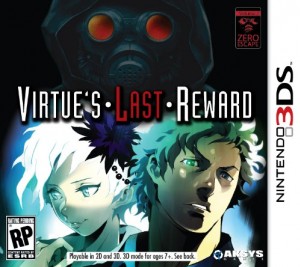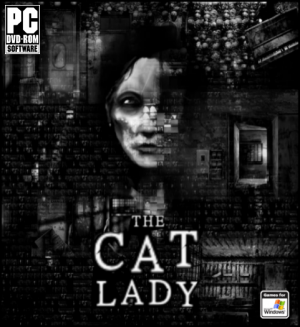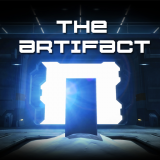Review for The Book of Unwritten Tales: The Critter Chronicles
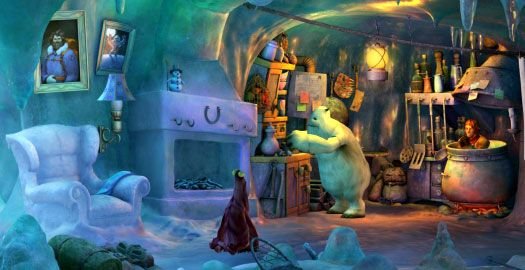
When a hopping mad, vengeful axe-wielding orc mercenary zooms into the rearview mirror on a fearsome flying interceptor, anyone who has played the acclaimed 2011 KING Art adventure The Book of Unwritten Tales is sure to get the warm fuzzies. After bounty hunter Ma'Zaz rides up beside Nate Bonnett's recently acquired airship to hijack him back to the Red Pirate's den for cheating him at cards, a flurry of tasks – some rational, some involving confetti and cotton balls – hurl you right into cannon fire as The Critter Chronicles takes off on an action-packed note. The craft soon crashes onto an ice shelf in the Northlands, however, and Nate finds himself in the soup du jour, his survival hinging on the shenanigans of the candy pink, lovelorn alien Critter. Add to the fray another not-so-friendly familiar face – the sniggering megalomaniac Munkus, a schizophrenic scientist and a rabid animal activist, and the stage is set just right for another clash of wonderfully dysfunctional personalities.
As a prequel to BOUT, The Critter Chronicles can be wholly enjoyed on its own merit by players new to the series, though given the numerous in-jokes based on the first game, this edition will definitely be funnier if the recognisable reference points pre-exist. The story recaps how Nate, an unabashedly selfish, narcissistic wannabe-adventurer met his furry sidekick and became (sort of) less selfish and narcissistic in his trusting, endearing company. There is also the issue of a stolen energy source that can give its owner unlimited power, which naturally attracts the wrong crowd. As an expansion of one of the most memorable adventures in recent years, this game carried great expectations, and it does try earnestly to fill its predecessor's oversized shoes, overcoming a few stumbles to succeed as an entertaining romp through an icy wasteland, but this time true greatness remains just out of reach.
Though the game takes ten to twelve hours to complete on the tougher of two difficulty modes, the dearth of diversity in locations and characters makes the experience feel repetitive in the second half. And along the way, quite a few of the inventory-based tasks are not logically set up and force you to randomly match objects to hotspots, which erodes both your patience and the charm of the game. On the plus side, The Critter Chronicles successfully incorporates many of BOUT's special qualities, like the steady flow of lighthearted quests; tandem play between Nate and Critter; pop culture-infested, irreverent humour; expert art and animation; cheekily familiar music; some excellent voice acting, and the feel-good little victories of the nice guys against near-insurmountable evil, to lure you into its borderline-insane world.
The story here is scaled down and kept more personal to Nate and Critter instead of segueing into a grand save-the-world saga. Nate wants a break from his mercenary life of fighting in the assorted factional wars plaguing their world, and now that he has his dream airship, the Mary, all he wants to do is retire to the balmy Southlands. Critter, meanwhile, is deemed too silly and inept to seek the hand of his beloved Layla by her father, the leader of the critters, and must find a way to improve his standing in their community. Even arch villain Munkus has a touching reason for coveting the machinery of the critters that will take him closer to world domination – his mother's approval, which he has been crushingly deprived of since childhood. Nate and Critter are circumstantially allied in a quid pro quo deal, which squares them off against Munkus and his Black Guards, as well as the lesser menaces of the indefatigable Ma'Zaz, Petra the judgmental activist, and an unhinged scientist named Cornelius who is hunting the elusive yeti.
The plot isn't particularly novel, but its threads are woven tightly to make a cohesive whole of the events that transpire to bring this group together, and will inevitably take them into the story of BOUT. Besides the pasts of Nate, Critter and Munkus, we learn about the provenance of the Mary, and how – and why – Critter becomes Nate's co-passenger. Initially, it's all about vested interests – Nate wants the critters to fix his crashed airship, and the critters want him to steal their energy source back from Munkus. The critters are shrewd enough to distrust the shifty Nate, however, and enlist Critter to shadow him to ensure he delivers his part of the bargain. Critter's innate innocence and loyalty eventually melts Nate's ice-cold heart, and they develop a quasi-brotherly bond as they plot the downfall of their mutual nemesis by infiltrating Munkus's fortified submarine and acquiring a magical weapon to beat him with. All short-term loops are neatly tied up by the time the party wraps up, and each character's arc gets a proper closure as the game draws to a satisfactory conclusion.
Most of the five chapters are set on the ice shelf in the Northlands. The short-ish first chapter is spent aboard the aging Mary while attempting to fend off Ma'Zaz's assaults, while the fourth covers a quick detour to Seastone to consult with the Arch Mage at his tower, though the actual village remains off-limits. The rest of the action is concentrated around four locations: the critters' state-of-the-art hideout, their junkyard of a workshop, a yeti cave and the submarine. This limitation is, in a strange paradox, both interesting and boring. The way the limited locations and the handful of items contained within are used and reused by Nate and Critter, jointly and separately, is fascinating in both imagination and execution. But at the same time, backtracking for hours around the dismal bluish-white landscape lugging ultra-ordinary objects with less than half a dozen characters to interact with – none of whom are truly coherent, literally or otherwise – will eventually have you straining for a reprieve.
The lower difficulty level is for those who found The Book of Unwritten Tales to be reasonably challenging, while the harder level is for players who want 'all the puzzles, all the pain'. The difference lies in the degree of complication in some of the tasks: in the easier mode, you'll be handed a required item, but if you play tough, you have to assemble it from its parts. In my quest for glory I chose the harder path, and I was stumped time and again – not by difficult quests, but by poorly-designed ones that I could solve only by indiscriminately combining objects and hotspots. Sometimes you have to repeat an activity till you get a result, but there is nothing to indicate this. At other times, you have to do things for no evident reason except that you have exhausted all other options. While a surprise visit from a famous fabled visitor solves a far-fetched problem, things take a turn for the worse at the Mage's Tower in Seastone, where the quests are as inexplicably twisted as the distorted perspectives of its interiors, especially the way Nate procures a painting from an animated gallery and his strategy for distracting a snappish plant.
Controlling the game, however, is easy and intuitive. Each screen has three or four items to be collected and a similar number of additional hotspots. Sweeping the mouse over a scene reveals hotspots whose labels appear at the lower edge of the screen. Left-clicking an object gets you either a detailed description from Nate or a garbled one from Critter, after which it can be collected or used. Right-clicking also describes an object, which is particularly relevant once objects have been acquired. The inventory, revealed by rolling the cursor over the bottom edge of the screen, stocks about half a dozen objects at a time. These are placed really close to each other, which requires you to take extra care when selecting an item to avoid picking up its neighbours. Logical item combinations turn the cursor red, which minimises guesswork and negative feedback and is a great help when you are forced to arbitrarily match objects. You get quite a bit of leeway in object combinations, and if some are not immediately useful, they can be detached back into their components. The space bar reveals all onscreen hotspots, and provides a reminder of your current objective. All exhausted hotspots are deactivated and inventory is cleared of used items immediately.
There are only three or four standalone puzzles, and unlike its predecessor, none in The Critter Chronicles require physical skill. The pedestrian fare offered here includes a paint-by-numbers exercise which has you conjure up fine art using a rather fat brush, a circular grid to be aligned correctly by rotating its rings, and picking a lock using the cross-section view. Puzzles can be exited while in progress, resetting them in the process, but they cannot be skipped (at least on the harder difficulty level).
From chapter three onwards, you play with both Nate and Critter, alternating between them as the situation demands using one-click selection. The two naturally have very dissimilar capabilities: Critter can slink in and out of spaces and easily camouflage himself, while tall and strong Nate is the choice to collect objects placed high up or to be wrenched out. They can also swap objects between each other, which adds to puzzle complexity because both the protagonist and the items need to be correct to solve each quest. Like in BOUT, in one area both are required to perform together, and though the activity is simple, the ensuing cinematic is exciting to watch. Alternating between the two takes time, however, as the idle one shuffles over to stand at a fixed spot on the screen each time he is deselected, and does not automatically follow the active character to other screens and must be manually guided there. These minor cribs aside, this cooperative style of solving problems flows smoothly between the two complementary characters, and is one of the most interesting and challenging aspects of the game, especially since there are several hours devoted to it instead of merely token inserts here and there.
As expected from this series, there are gags galore, both visual and dialogue-based. References to movies, video games, comics and popular topics, real and fictitious, continue unabated, and many jokes are made at the expense of absent series members like the paladin who liked to play dress up. Sci-fi series like Star Wars and Star Trek get the most frequent nods, with the Mary ostensibly making the Kessel run in two days (believable, given the list of previous owners), Layla's Princess Leia hairdo, and Critter's Vulcan-style goodbye, but you also encounter the infamous Borat outfit and there's a veritable treat in store for fans of Day of the Tentacle. The humour extends to the commands when you combine objects and the chapter load screens, which list activities like 'polish penguins' and 'pay lawyers', and continues even after the credits roll. But though the penguins put in serious overtime to keep the comedy flowing, there are no truly memorable sequences like the Mummy or the Daemon Monkey of BOUT, especially since the two new characters, Cornelius and Petra, never really bring on the laughs.
Similarly, despite being modeled as a cheeky blend of adventuring icons Han Solo and Guybrush Threepwood and having the best lines, Nate is still not charismatic enough to win your heart as the reluctant hero. His constant, strident whining about his misfortunes mires down his golden-hearted bad boy role, and he loses the personality battle in most of his interactions, be it with Critter or Munkus or his ship's talking figurehead, whether overrun by logic, derision, or good old sass. Critter has a more robust value system and consistent persona, and carries a good chunk of the game on his non-existent shoulders, though the charm of his over-repeated gobbledygook phrases wanes after a while.
Like the landscape, the list of supporting characters is a little barren, but most try hard to pick up the slack. Despite their evil agendas, Munkus and Ma'Zaz both entertain – the former's psychopathic pleasantness and sniggering is hilarious, while ultra-professional Ma'Zaz provides some understated humour. Middle-aged wall fixture Mary is delightfully dignified and takes no lip from her 'captain' Nate, and her maiden encounter with Critter is subtle but funny. Crazy Cornelius fluctuates alarmingly between paranoid scientist and a culinarily-inclined mythical creature, while Petra haranguing all and sundry with her save-the-animals spiel is just the right amount of aggravating. Superb cameos by a baby critter and the Arch Mage's portrait offset the unfortunately dull, whispery Layla, and the speechless penguins never fail to make you laugh with their bizarre background antics.
The Critter Chronicles boasts similar art and animation as BOUT, with attractively detailed, artistically off-kilter backgrounds. Though the icy landscape restricts the colour palette to pale blues and white for most of the game, inviting warmth is generated by the critters' vibrant hideout, the homey yeti cave, and the overheated interiors of the submarine. The simple but visually striking screen transition between the ice shelf and the submarine deserves extra credit, as do the extremely odd wall-and-floor arrangements of the Mage's Tower, which induce spectacular disorientation. Many subtle touches add realism to the scenes, like the smudge left behind when a long-pinned object is removed from a wall, reflections on polished surfaces, and background animation like rising smoke and wind-whipped flags. There are a couple of glitches, though, including a notable one during a quest which makes a pair of essential earmuffs appear and disappear without reason.
The extensive character animation is smooth and realistic, barring some jagged edges and a few missteps here and there, like Nate's over-the-top swagger-walk, which from the side makes him look like he's skating. Characters interact visibly with each object they collect and use (it's a bit worrying to witness Critter stowing kitchen knives and conveyor belts in his gullet), and whether it is a minor action like Nate blowing a Mardi Gras whistle or a detailed one like Critter force-feeding a penguin, every activity is eye-catching and often contributes to great physical comedy. Considerable non-essential animation adds to the visual drama, such as when Ma'Zaz is startled by Nate suddenly rattling his cage, the yeti lightly dusting Nate with salt as he preps for dinner, and Critter's arms whipping up impromptu sessions of Dumb Charades as he tries to get his point across. Though a few activities occur offscreen, the fully-animated cinematics are seamlessly integrated with the gameplay instead of being distinct interludes. Lip sync and eye movement match the spoken dialogues efficiently to create credible expressions. Upping the edge smoothness setting for characters to 'very high' makes a significant improvement to the quality of animation.
The musical score has a host of almost-familiar tunes derived from popular games and movies, and carries over quite a few from BOUT. Situation-specific orchestral compositions play almost continuously in the background, though there are distinct pauses between tracks. Background sound includes rushing wind when out on the ice shelf and the crackle of fires indoors, providing the base for an impressive collection of sound effects that accompany each onscreen activity, like a skeleton arm skittering across a wooden floor, Critter scratching his butt, and the all-too-painfully-correct grinding of a rusted tabletop.
The sole annoying aspect of the production for me was the loudness and artificiality of Nate's voiceover. The same actor reprises his role from BOUT and continues to be inconsistent to the point of distraction: he shouts out the latter half of sentences as if he's talking to someone hard of hearing, and the lack of nuance wastes some clever one-liners. Dialogues are often incorrectly inflected, and stand out sorely against the finesse with which the supporting cast is voiced, particularly Munkus, Mary and the Arch Mage's portrait. Nate also sounds too old for his incessant whining to be endearing. Layla's childlike diction is a bit hammy and irritating as well. Critter can phonetically speak some English words like 'pliizz' and 'bok-ss' but usually jabbers in Critterspeak. Fortunately, the rest of his tribe speaks normally. The baby critter, in fact, is the pièce de résistance of the mostly-stellar guest cast, and definitely warranted some more screen-time.
Following in the wake of the exceptional The Book of Unwritten Tales, The Critter Chronicles was inevitably destined for an uphill trek to achieve the same player satisfaction. Using only two of the four protagonists from the original, the prequel smartly decides to play for smaller stakes, and keeps its story and scope simple and limited, and thereby manageable, while regaling you with the same top-of-the-line scriptwriting and production quality. Most of it works: the sacrifices Critter makes for his tribe and friends; Nate's redemption in the face of tantalising temptation; the cooperative gameplay with Nate and Critter; some terrific one-liners; and of course, the bad guys getting beaten back for another day. But an overly-limited, often visually bleak game world warranting hours of backtracking around the same few screens, a host of random quests that force arbitrary object-matching, and irritating voice acting for Nate reduce the potentially-exhilarating experience to a bit of a slog at times. It's still an entertaining ride overall, however, and easily recommended for any traditional adventure fan who appreciates a sleek production peppered with pop culture references.
WHERE CAN I DOWNLOAD The Book of Unwritten Tales: The Critter Chronicles
The Book of Unwritten Tales: The Critter Chronicles is available at:
- GOG -75%
- HumbleBundle
- Amazon


